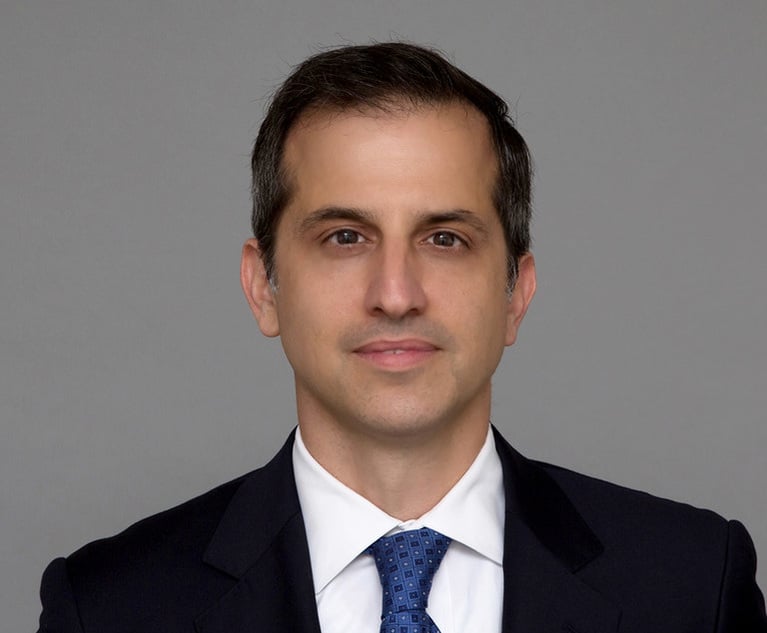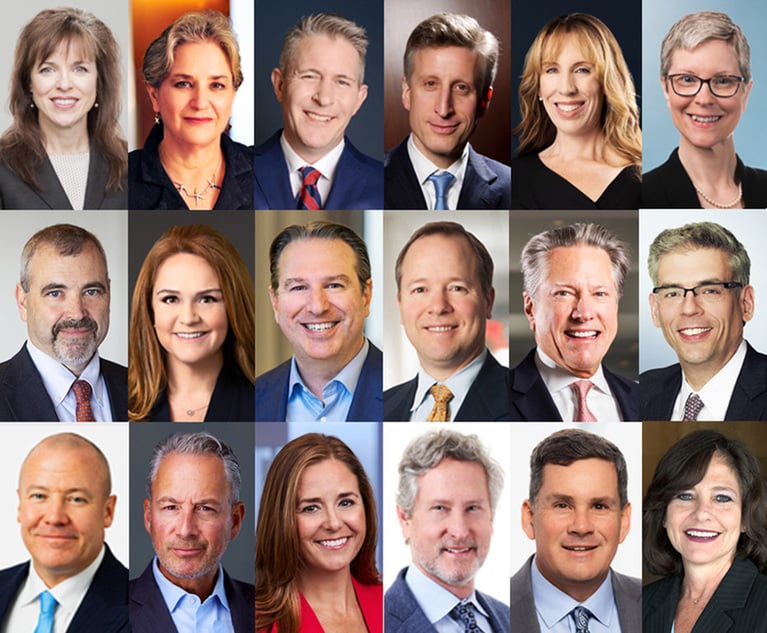 (L-R)Lit Daily of Gibson Dunn's Mitchell Karlan, Lee Dunst & Nancy Hart
(L-R)Lit Daily of Gibson Dunn's Mitchell Karlan, Lee Dunst & Nancy HartLitigators of the Week: A Billion Dollar Save for Gibson Dunn Trio
'From day one, we recognized that our biggest challenge was the potential that understandable high emotion could overwhelm the jury,' said Gibson Dun's Nancy Hart.
March 12, 2020 at 11:59 PM
12 minute read
The Litigator of the Week crown goes to Gibson, Dunn & Crutcher's Mitch Karlan, Lee Dunst and Nancy Hart, who after a three-week trial, persuaded a jury in Cleveland federal court to side with their client Textron Financial Corp.
The lender was hit with a $1 billion suit by the bankruptcy trustee for Fair Finance Co., an Ohio company that collapsed in 2009 as a result of a massive criminal fraud. The victims—among them an elderly nun who testified about losing her life savings—were deeply sympathetic, but the Gibson Dunn team successfully countered that their client did nothing wrong.
They discussed the win with Lit Daily.
Who is your client and what was at stake?
Mitch Karlan: We represent Textron Financial Corporation, a Kansas-based company that previously had engaged in the asset based lending business and previously made loans to middle-market private companies across the U.S.
In the early 2000s, TFC had extended a standard revolving line of credit to Fair Finance Company, a successful Ohio-based business that ran a profitable factoring business. Years after TFC exited the loan, Fair Finance spectacularly imploded after the FBI raided its offices and discovered that its larger-than-life CEO, Tim Durham, and others, had engaged in a massive criminal fraud whereby they stole tens of millions of dollars from Ohio investors to support a lavish personal lifestyle, such as high-stakes gambling, fancy cars, yachts and bacchanal-like parties in Indianapolis with Playboy models flown in from Los Angeles.
Durham and his buddies were arrested and later convicted on federal fraud charges in 2012 and currently are serving lengthy prison sentences. All told, the Ohio investors lost more than $300 million due to Durham's fraud.
Lee Dunst: Enter the bankruptcy trustee for Fair Finance. Fair Finance later filed for bankruptcy in 2010, following the FBI raid, and the trustee filed suits against anyone and everyone who touched Fair in the years leading up to its collapse, including accountants, lawyers, employees and lenders, including TFC.
In 2012, the bankruptcy trustee filed a far-ranging complaint in federal court in Cleveland against TFC and the other lender (which later settled with the trustee), alleging fraudulent transfer and conspiracy (among other claims) and seeking damages from TFC of nearly $1 billion.
Nancy Hart: Given the dramatic backdrop of the Fair Finance eventual downfall and Durham's criminal conviction, we knew we needed to focus on understanding how different the world looked during the TFC loan so we could communicate that story, as well as identify any legal arguments to attack the Trustee's claims and damages.
In these situations, hindsight bias can color everything that happened earlier in time. But back in early 2002, before he became the poster child for corporate greed and personal excess, Tim Durham was considered a highly respected entrepreneur and multi-millionaire from Indiana who purchased Fair and continued to run that business successfully for years. Our lens focused on going step-by-step through the life of the loan to understand how that business changed when Durham came on and how TFC responded.
When and how did you get involved?
Mitch Karlan: We were hired right after the lawsuit was filed. We previously had done work for this client—I had defended them in other civil lawsuits and Lee (who is a former assistant U.S. attorney) represented them in connection with other matters. At the outset of the case, Nancy and I led the efforts in briefing the legal issues, while Lee handled the many former TFC employees and also interacted with the federal prosecutors in connection with Durham's criminal trial in Indianapolis.
Who was opposing counsel?
Baker Hostetler.
What was the overarching theme of your defense?
Mitch Karlan: We had a multi-prong defense over the eight years of hard-fought litigation. First, we aggressively attacked the over-broad nine separate legal claims in the original complaint and were successful in paring it down to a single fraudulent transfer claim, and slashing the potential recovery from nearly $1 billion to approximately $317 million. Nancy led this admirable effort over time.
Nancy Hart: Next, we worked to focus the jury on a key threshold legal question—whether the initial lien that TFC placed on Fair's assets in 2002 was extinguished when Fair negotiated a new agreement in 2004. This was critical because if that original lien was in place, TFC would be legally shielded by the very provisions of the Ohio bankruptcy statute from efforts by the trustee to claw back millions of dollars. We had to figure out a way to explain this complicated—and highly technical—legal question to a jury in an easy way to make sure that they reached the correct outcome.
Lee Dunst: Finally, we sought to demonstrate to the jury that TFC acted in good faith in its lending relationship with Fair. Throughout the trial, we stressed that TFC did not put its head in the sand and, to the contrary, it identified issues about how Durham was running his business and pressed him to change his ways and ensure that the Ohio regulators approved of his disclosures to Ohio investors. We made the case to the jury that TFC went above and beyond what is generally expected of a lender.
This case involved facts from more than 15 years ago and many of the key witnesses were located outside the reach of the court in Cleveland. How did you address these significant evidentiary challenges?
Lee Dunst: We understood this be a potential issue in the case and we took it on at the very beginning. Knowing that many of these witnesses lived outside Ohio and could not be forced to come to trial, we approached the depositions in the case like it was trial testimony. We went to where the witnesses lived in Florida, Georgia and Indiana and conducted their depositions in a trial-like way.
We used documents (many of which were more than decade old) like trial evidence and secured critical testimony at the depositions that we later could use at trial, even though the witnesses were not there. This forced us to think way ahead about our trial strategy, as many of the depositions occurred almost three years before trial, but that effort paid off in the end.
The bankruptcy trustee's complaint was the result of a massive criminal fraud that resulted in the collapse of the company and huge investor losses. What special challenges did this create for your defense?
Nancy Hart: From day one, we recognized that our biggest challenge was the potential that understandable high emotion could overwhelm the jury. We were faced with a situation where Durham ultimately looted the company for his personal life of excess at the expense of Ohio investors who lost hundreds of millions of dollars. We needed to acknowledge that all of this occurred but also ensure that the jury not cast blame incorrectly on TFC, when the real culprit was Durham who is sitting in federal prison for the rest of his life.
Lee Dunst: One example of this challenge was the trustee's effort to put on potentially explosive testimony from several Ohio investors who had lost all their money and had tragic personal stories. In the lead-up to the trial, we filed multiple successful motions to sharply cut back this testimony citing the potential for unfair prejudice and the judge agreed with us.
However, the trustee was still permitted to put one such witness on the stand—an elderly retired nun who had lost her entire life savings due to Durham's fraud. Recognizing the obvious pitfalls here, we adopted a strategic approach to how to handle her and succeeded in defusing any undue and improper prejudice from this highly sympathetic witness.
Who were the primary members of your team and what strengths did they bring to the representation?
Mitch Karlan: We had a core team who had been defending TFC since the complaint was filed in 2012. I led the defense team and did opening and closing arguments to the jury. Lee handled all the former TFC employees in their depositions which later were played at trial and also examined two critical TFC witnesses in person at trial and elicited important testimony on the threshold lien issue. Nancy managed the multiple successful legal motions that we filed throughout the case, as well as conducted effective examinations of our expert witnesses at trial.
Further, our local counsel, Quintin Lindsmith of Bricker & Eckler, played a key role in jury selection and also examined a key trial witness on the lien issue. And, of course, none of this would have been possible without the extraordinary team of Gibson Dunn associates in New York.
Trial lasted nearly three weeks. Tell us about a high (or low) point.
Nancy Hart: We knew from the beginning that we were dealing with many internal company documents which used colorful language (such as "piggy bank" or "house of cards") and the trustee repeatedly read these out of context with the jury throughout the first week of trial. This was frustrating to hear again and again. But we stuck to our trial strategy and put on a spirited defense during the second week and presented multiple witnesses who painted a totally different picture for the jury.
Lee Dunst: Another point—that went from a low to a high—was in connection with getting the live testimony of a senior representative of the Ohio Division of Securities, which oversaw the investment offerings Fair Finance made to Ohio investors (the main conduit through which Durham orchestrated his fraud).
We had issued a subpoena to the Ohio Division of Securities, but it had filed a motion to quash resisting producing a witness. This was being briefed during trial, so it was not until we were mid-way through that we got the ruling that the representative would need to appear in person. His testimony was critical in helping tell the bigger story and shift the focus in part away from TFC.
Your adversary focused a key part of their case on extremely sympathetic victims of the criminal fraud and the theft of investor funds to support a lavish lifestyle of the fraudsters who are now in prison. Were you worried that this would turn off the jury and how did you handle this risk?
Nancy Hart: As expected, the Trustee made repeated reference to the victims of Durham's scam—many of whom were elderly—and put on a parade of photos of Durham's yachts, antique and exotic cars, and a luxury Miami condo that he had bought with money that he stole from Ohio investors (and TFC, as it turned out).
We certainly were concerned that a jury might be swayed by pure emotion. However, we dealt with this through our expert witnesses who methodically showed that TFC had no involvement with Durham's fraud and that TFC had done the right thing at the time. Also, we kept bringing the jury back to the key threshold issue about the validity of our lien which had nothing to do with Durham's crimes.
Did you make any unconventional strategic choices in litigating the case?
Lee Dunst: While we had to fight the trustee's arguments on multiple fronts, we had to focus the jury's attention on the critical question of the primacy of TFC's original lien on Fair's property because if we won this point, then it was game over for the trustee's case. But this was a complex legal question that a jury might not understand. So we ensured through opening and closing arguments and with multiple live witnesses to explain this potentially dry legal question to the jury in order to ensure that they got it. And the favorable jury verdict in TFC's favor showed the success of this strategy.
What will you remember most about this trial? And what message do you hope the verdict sends?
Mitch Karlan: The trial was the end of a long eight-year road from the trustee's filing of an overblown complaint seeking nearly $1 billion in damages to our complete and total victory provided by 10 hard-working jurors in a Cleveland courtroom. We were committed to the strength of our arguments from the beginning and, notwithstanding the seriousness of Durham's fraud and the severe damage that he caused to his investors, we were gratified with the ultimate outcome at trial that TFC was not liable for Durham's misdeeds.
This content has been archived. It is available through our partners, LexisNexis® and Bloomberg Law.
To view this content, please continue to their sites.
Not a Lexis Subscriber?
Subscribe Now
Not a Bloomberg Law Subscriber?
Subscribe Now
NOT FOR REPRINT
© 2025 ALM Global, LLC, All Rights Reserved. Request academic re-use from www.copyright.com. All other uses, submit a request to [email protected]. For more information visit Asset & Logo Licensing.
You Might Like
View All
Big Company Insiders See Technology-Related Disputes Teed Up for 2025

Litigation Leaders: Jason Leckerman of Ballard Spahr on Growing the Department by a Third Via Merger with Lane Powell

Litigation Leaders: Greenspoon Marder’s Beth-Ann Krimsky on What Makes Her Team ‘Prepared, Compassionate and Wicked Smart’
Law Firms Mentioned
Trending Stories
- 1Courts, Lawyers Press On With Business as SoCal Wildfires Rage
- 2Florida, a Political Epicenter, Is the Site of Brownstein Hyatt's 13th Office
- 3Law Firms Close Southern California Offices Amid Devastating Wildfires
- 4Lawsuit alleges racial and gender discrimination led to an Air Force contractor's death at California airfield
- 5Holland & Knight Picks Up 8 Private Wealth Lawyers in Los Angeles
Who Got The Work
Michael G. Bongiorno, Andrew Scott Dulberg and Elizabeth E. Driscoll from Wilmer Cutler Pickering Hale and Dorr have stepped in to represent Symbotic Inc., an A.I.-enabled technology platform that focuses on increasing supply chain efficiency, and other defendants in a pending shareholder derivative lawsuit. The case, filed Oct. 2 in Massachusetts District Court by the Brown Law Firm on behalf of Stephen Austen, accuses certain officers and directors of misleading investors in regard to Symbotic's potential for margin growth by failing to disclose that the company was not equipped to timely deploy its systems or manage expenses through project delays. The case, assigned to U.S. District Judge Nathaniel M. Gorton, is 1:24-cv-12522, Austen v. Cohen et al.
Who Got The Work
Edmund Polubinski and Marie Killmond of Davis Polk & Wardwell have entered appearances for data platform software development company MongoDB and other defendants in a pending shareholder derivative lawsuit. The action, filed Oct. 7 in New York Southern District Court by the Brown Law Firm, accuses the company's directors and/or officers of falsely expressing confidence in the company’s restructuring of its sales incentive plan and downplaying the severity of decreases in its upfront commitments. The case is 1:24-cv-07594, Roy v. Ittycheria et al.
Who Got The Work
Amy O. Bruchs and Kurt F. Ellison of Michael Best & Friedrich have entered appearances for Epic Systems Corp. in a pending employment discrimination lawsuit. The suit was filed Sept. 7 in Wisconsin Western District Court by Levine Eisberner LLC and Siri & Glimstad on behalf of a project manager who claims that he was wrongfully terminated after applying for a religious exemption to the defendant's COVID-19 vaccine mandate. The case, assigned to U.S. Magistrate Judge Anita Marie Boor, is 3:24-cv-00630, Secker, Nathan v. Epic Systems Corporation.
Who Got The Work
David X. Sullivan, Thomas J. Finn and Gregory A. Hall from McCarter & English have entered appearances for Sunrun Installation Services in a pending civil rights lawsuit. The complaint was filed Sept. 4 in Connecticut District Court by attorney Robert M. Berke on behalf of former employee George Edward Steins, who was arrested and charged with employing an unregistered home improvement salesperson. The complaint alleges that had Sunrun informed the Connecticut Department of Consumer Protection that the plaintiff's employment had ended in 2017 and that he no longer held Sunrun's home improvement contractor license, he would not have been hit with charges, which were dismissed in May 2024. The case, assigned to U.S. District Judge Jeffrey A. Meyer, is 3:24-cv-01423, Steins v. Sunrun, Inc. et al.
Who Got The Work
Greenberg Traurig shareholder Joshua L. Raskin has entered an appearance for boohoo.com UK Ltd. in a pending patent infringement lawsuit. The suit, filed Sept. 3 in Texas Eastern District Court by Rozier Hardt McDonough on behalf of Alto Dynamics, asserts five patents related to an online shopping platform. The case, assigned to U.S. District Judge Rodney Gilstrap, is 2:24-cv-00719, Alto Dynamics, LLC v. boohoo.com UK Limited.
Featured Firms
Law Offices of Gary Martin Hays & Associates, P.C.
(470) 294-1674
Law Offices of Mark E. Salomone
(857) 444-6468
Smith & Hassler
(713) 739-1250







